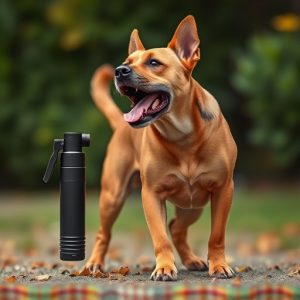Dog Repellent Spray: Effective Protection & Safe Application Tips
Dog repellent spray is a popular tool for protecting against unwanted canine interactions, using unp…….
Dog repellent spray is a popular tool for protecting against unwanted canine interactions, using unpleasant sensory experiences to deter dogs. The best way to store it involves keeping them in cool, dry places out of reach of children and pets, maintaining effectiveness and safety. Selection should align with specific needs and environmental factors, considering scent, application method, and desired protection. Effective use requires strategic application, regular reapplication, and adherence to storage guidelines. For lasting solutions, combining repellents with training, behavior modification, and property security creates a safer environment without relying solely on chemicals.
Discover the best way to protect yourself and your property from unwanted canine visitors with our comprehensive guide. We explore dog repellent spray as a safe, effective solution for deterring dogs from specific areas. Understanding the purpose and types of these sprays is key, and we’ll help you choose the best option tailored to your needs. Learn safe application practices, storage and disposal considerations, and even alternatives beyond spray for ultimate canine deterrence.
- Understanding Dog Repellent Spray: Purpose and Types
- Choosing the Best Dog Repellent Spray for Your Needs
- Safe Application Practices: How to Use Dog Repellent Spray Effectively
- Storage and Disposal Considerations for Canine Repellents
- Exploring Alternatives: Beyond Spray for Dog Deterrence
Understanding Dog Repellent Spray: Purpose and Types
Dog repellent spray is a popular and effective method for protecting against unwanted canine interactions, whether in your backyard, on hiking trails, or while camping. Understanding its purpose and types is the best way to store dog repellent spray safely and efficiently. The primary goal of this spray is to deter dogs from approaching or entering specific areas by creating an unpleasant sensory experience. It works by emitting a scent or producing an irritation that makes dogs reluctant to stay in the treated area.
There are several types available, each formulated for different purposes. Some sprays use natural ingredients like capsaicin (from chili peppers) or citronella, which are safe for pets and humans but can startle dogs. Others employ synthetic chemicals designed to mimic a dog’s natural fear triggers. When choosing the best way to store dog repellent spray, consider factors like usage frequency, environmental conditions, and personal preferences. Keeping them out of reach of children and pets, in cool, dry places, is crucial for maintaining their effectiveness and safety.
Choosing the Best Dog Repellent Spray for Your Needs
When selecting a dog repellent spray, understanding your specific needs is key. Different sprays are formulated for various purposes—be it to deter dogs from entering certain areas, preventing aggression, or controlling barking. The best way to store and choose a dog repellent spray is by considering the environment you want to protect. For instance, if you’re dealing with an invasive dog in your garden, opt for a spray designed for outdoor use that is safe for plants and animals.
Additionally, factors like scent and application method play significant roles. Some sprays use natural ingredients with stronger smells, while others employ more synthetic, undetectable formulas. Consider the accessibility of the spray—is it easily applicable on hard surfaces or in tight spaces? Choosing a repellent that aligns with your comfort level and the unique challenges you face will ensure effective protection for both you and your desired space.
Safe Application Practices: How to Use Dog Repellent Spray Effectively
Using dog repellent spray effectively requires a strategic approach and adherence to safe application practices. Begin by selecting a high-quality product designed specifically for canine deterrence, ensuring it’s pet-safe and environmentally friendly. Check labels for active ingredients, concentration levels, and usage instructions. The best way to store dog repellent spray is in a cool, dry place away from direct sunlight and heat sources, following the manufacturer’s guidelines. Before application, ensure your hands are clean, and put on protective gear if recommended by the product. Spray the solution liberally but evenly onto the intended areas, focusing on places dogs frequently access or where they have shown unwanted behavior. Avoid spraying directly at animals to prevent any potential harm. Regular reapplication is key; follow the manufacturer’s guidelines for frequency, usually after rainfall and at intervals as needed.
Storage and Disposal Considerations for Canine Repellents
When storing canine repellent spray, it’s crucial to keep them out of reach from both your pets and children. The best way to store dog repellent spray is in a cool, dry place, away from direct sunlight. Ensure the container is tightly closed to prevent any leakage or evaporation. Avoid storing them near heat sources like radiators or heaters, as extreme temperatures can affect the spray’s effectiveness.
Disposal of canine repellents should be done responsibly and according to local regulations. Never dispose of these sprays down the drain or in regular trash bins. Check for specific guidelines on how to dispose of chemical waste in your area. Some manufacturers offer take-back programs, allowing you to return used containers safely. Remember, responsible storage and disposal contribute to a safer environment for both your pets and the community.
Exploring Alternatives: Beyond Spray for Dog Deterrence
In the quest for effective dog deterrence, many individuals turn to spray-based solutions as a quick fix. However, exploring alternatives beyond canine repellent spray is essential, especially when considering long-term strategies for dog protection. The best way to store dog repellent spray is not merely about application but also understanding the root causes of dog aggression or intrusion.
Instead of solely relying on sprays, which may have limited effectiveness and potential health concerns, consider implementing a multi-layered approach. Training and behavior modification techniques can be highly effective in teaching dogs appropriate boundaries. Positive reinforcement methods, for instance, can encourage good behavior while deterring unwanted actions. Additionally, ensuring your property is securely fenced and maintaining regular interaction with nearby dogs can contribute to a safer environment without resorting to chemical repellents.
The best way to store dog repellent spray is in a cool, dry place, out of reach of pets and children. Always follow safe application practices and disposal guidelines to ensure effectiveness and minimize environmental impact. While spray remains a popular choice for dog deterrence, exploring alternatives can offer long-lasting solutions tailored to specific needs. By understanding the various options available, you can make an informed decision to protect your space and keep dogs at bay safely and humanely.


